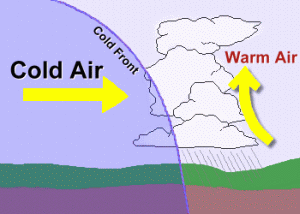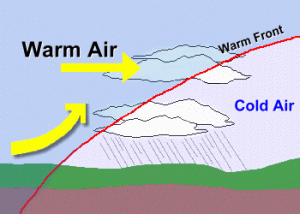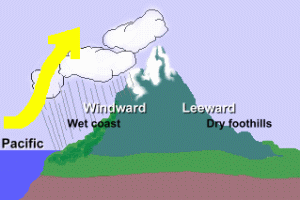|
Weather can change quickly, and it is due to the movement of air masses in the atmosphere. An air mass is a large chunk of air ... often many tens of miles wide ... that shares the same temperature and humidity. When two different air masses meet, the boundary between them is called a front, and bad weather is usually the result. The principle that causes storms is a simple one ... when air rises, it expands and cools. Cooling occurs at the rate of about 10°C per kilometre. The water vapour in the air soon condenses into water droplets, which form clouds, and eventually these droplets fall from the sky as rain. Storms can occur when two very different air masses meet. Let's look at two possibilities.   A Cold Front A Cold Front This happens when a fast-moving mass of cold air hits a warm air mass. The warm air, which holds a lot of water vapour, gets pushed upward. The water vapour condenses to water droplets, which form tall clouds. Eventually the weight of the drops can no longer be supported by the air, and they fall. This type of storm is often violent, with a lot of thunder and lightning, and heavy rain in a short period of time. But it ends quickly.  A Warm Front
A Warm FrontA warm front happens when a fast moving mass of warm air encounters a cold air mass, and rides up on top of it. The warm, humid air eventually rises high enough for water droplets and clouds to form, and rain to fall. This type of storm usually covers more area, lasts longer, and will produce a steady rain for a long period of time. Thunder and lightning often accompany the storm , but of a less violent nature than in a cold front.  Rainfall also occurs where warm, humid air is forced to rise as it passes over mountains or large hot cities. The warm air goes up, water vapour condenses to droplets and clouds, and it rains. On mountains, this happens on the windward side (the side the wind is coming from). By the time the air mass reaches the leeward side (the far side), all its water has fallen, and the air is dry. Rainfall also occurs where warm, humid air is forced to rise as it passes over mountains or large hot cities. The warm air goes up, water vapour condenses to droplets and clouds, and it rains. On mountains, this happens on the windward side (the side the wind is coming from). By the time the air mass reaches the leeward side (the far side), all its water has fallen, and the air is dry.You can see this effect in the Rocky Mountains. The wind come from the west, where it has picked up a lot of moisture from the Pacific Ocean. As it rises over the Rockies, water vapour condenses and falls as rain. The west side of the Rockies gets a lot of rain. By the time the winds reach the far side, they're dry ... the foothills there get very little rain. Air Pressure You probably know that a barometer measures air pressure, and can tell you something about what the weather is going to be like. Rising air pressure means good weather is coming, and dropping air pressure means that bad weather is on the way. Here's the explanation. Air masses are constantly moving. In some places air is going up; in other places it is falling. In between, air is moving parallel to the surface ... causing winds. When you are experiencing low pressure, it usually means that air above you is rising, and expanding. This rising, expanding air will cool, forcing its water vapour to condense, clouds to form, and maybe rain to fall. If you are experiencing high pressure, it probably means that the air above you is falling, and compressing. As this air falls, it gets warmer. This means it can hold more water vapour, so any clouds that exist will evaporate, leaving a clear sky. |